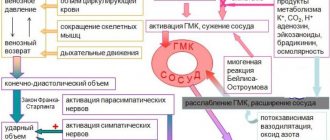Dizziness
It happens that there are no physiological reasons for dizziness. The body, at first glance, is healthy and works great, but the head still feels dizzy again and again. If something similar has happened to you, think about how you felt before the dizziness. Perhaps severe fear or anxiety? Panic? In this case, it is quite possible that your dizziness was psychogenic.
Psychogenic dizziness is dizziness caused by a person's psychological or emotional state. Sometimes it is called imaginary because, unlike true dizziness, it is not associated with a disruption of the vestibular apparatus. [1] Actually, this is why the sensations during attacks of vestibular and psychogenic dizziness are so different: vestibular dizziness is similar to movement, rotation, and psychogenic dizziness is similar to fog in the head, instability, fear of falling, lightheadedness, etc. [2][3]
Despite the fact that psychogenic dizziness occurs due to emotional problems, its symptoms can be very real. For example, shortness of breath, sweating, tinnitus, headache, rapid heartbeat, etc. [1]
How to understand that dizziness is psychogenic?
Only a specialist can find out. During diagnosis, he must, first of all, exclude all other possible causes of dizziness. To do this, he needs to find out from you as much as possible about the conditions under which attacks occur, how long they last and what they look like, whether they are accompanied by other symptoms, etc. In some cases, additional examination by several specialists (otoneurologist, cardiologist, hematologist, etc.), laboratory and radiation diagnostics, as well as additional studies (for example, a study of balance or the condition of the inner ear, ECG, etc.) may be necessary. [2][3]
After the doctor is convinced that you have psychogenic dizziness, you need to understand what kind of disorder caused it. Most often these are [1]:
Anxiety or anxiety-depressive disorders (they are felt as anxiety, constant fears for loved ones, sudden mood swings, worry about little things, tension, stiffness, loss of sleep, decreased performance, increased fatigue, muscle and other pain, etc.) [ 4]
Panic disorder (characterized by recurrent panic attacks and anxiety in anticipation of a new attack). [5] Panic attacks include fear, shortness of breath, palpitations, nausea, weakness, lightheadedness, lightheadedness, fear of falling, and loss of balance. Panic attack is one of the most common anxiety disorders, which approximately 3% of the population has experienced at least once in their lives. [6]
Phobic postural vertigo can be described as a feeling of instability in the form of attacks. Simply put, it feels like a momentary loss of balance. It can occur spontaneously, but is more often associated with specific stimuli or situations that cause fear (i.e., phobias). [4][7]
Uncontrollable dizziness. Difficulties in diagnosis and treatment
Transcript of the report of Professor N.S. Alekseeva, dedicated to the treatment of dizziness.
Professor Drapkina O.M.: – We are moving into a fascinating area for therapists – neurology. And today, in fact, I would say, Professor Natalya Stepanovna Alekseeva will open and support this entire section. "Uncontrollable vertigo."
Professor Alekseeva N.S.: – “Unruly dizziness: diagnosis and treatment” is the topic of our lecture. Why did we call it that? Because many doctors of different specialties - therapists, cardiologists, otolaryngologists - see patients almost every day with complaints of dizziness. However, realizing that dizziness is most often caused by pathology of the vestibular apparatus, they propose to carry out their own treatment regimens and do not get a good enough effect as a result of this treatment. That is why we gave this report the title that there is dizziness, but it is not so easily controlled by the doctor in terms of treatment.
Accordingly, two problems arise here. First: in order to properly treat dizziness, it is necessary to correctly diagnose the level of damage to the vestibular apparatus. And second: you still need to understand how much which disease is more likely to cause this dizziness. These are vascular processes, this is an inflammatory process in the ear. For this, of course, we need a detailed medical history; without this we can’t go anywhere.
But since, after all, my experience shows that the largest number of patients suffering from dizziness are vascular patients, and in the first place, perhaps, I would still put patients with arterial hypertension, then the following material clearly shows that patients with arterial hypertension are mainly those patients who complain of dizziness, tinnitus, their dizziness occurs in different ways. These may be attacks of short-term rotational dizziness, often associated with a change in position. Unsteadiness when walking, drunken gait or unsystematic dizziness, sometimes even with a fall. Often the appearance or worsening of dizziness indicates an increase in blood pressure.
Dizziness can be of vestibular origin - it is a peripheral lesion. The classic example is Meniere's disease or syndrome, or associated with other causes of orthostatic hypotension, syncope and other conditions. Much more often, dizziness is a symptom of damage to the vestibular analyzer, both at the peripheral and central levels. It must be said that the vestibular analyzer is widely represented in the central nervous system, and it extends from the labyrinth of the inner ear outside the brain structure to the temporal cortex of the brain. Moreover, its influence on the central nervous system can be compared with the influence of the vagus on the periphery, because, indeed, to stabilize the vertical position and comfort when changing the position of the head and body, the influence of such a powerful analyzer, which has powerful connections in the central nervous system, is necessary.
The target organs for arterial hypertension can be various parts of the brain, as well as the labyrinth. In the brain, these are the trunk, cerebellum, and cerebral hemispheres. The age category of patients with arterial hypertension are middle-aged and elderly patients. It is important to note that the difference in blood pressure in middle-aged people with the development of hypertension in middle-aged people already at an early stage of the disease can lead to cerebral complications, transient ischemic attacks and cause cerebral infarction and dyscirculatory encephalopathy.
Thus, when classifying cochleovestibular disorders, we distinguish the peripheral level, in which we distinguish two levels: labyrinthine and radicular, that is, the inner ear and the vestibular nerve to the nuclei. Central lesion: subtentorial truncal lesion and supratentorial lesion. And, of course, there are patients with the combined syndrome.
To get a good idea of how broad the scope of diseases that can lead to dizziness is, I compared the levels of damage - from the peripheral to the cerebral cortex - with those diseases that are most common. And you see that the right half of the table shows Meniere’s disease, vascular disorders in the labyrinthine artery, which occur as thrombosis of this artery, and cracks in the pyramid of the temporal bones, damaging the inner ear and the vestibular portion of the VIII nerve. This is also intoxication with toxic antibiotics, these are otogenic inflammatory processes - arachnoiditis - of the cerebellopontine angle, these are neuritis of the vestibular portion, causing dizziness. It is also very important that a pathology such as a neurovascular conflict has become very common, when the vessel is adjacent close to the auditory nerve and the vestibular portion, and against the background of an increase in blood pressure in the vessel in the intracranial section, pressure of the vestibular nerve and an attack of dizziness are caused with a complete shutdown of the labyrinth for one side, which leads to a fall, but without loss of consciousness. In addition, small intracanal neuromas are also accompanied by dizziness in the early stages of development.
But the largest number of patients, of course, are patients with vascular disorders in the vertebrobasilar system against the background of not only arterial hypertension, but atherosclerosis, vascular thrombosis, hemorrhagic disorders and acute ischemic cerebrovascular accident. But this is not only vascular pathology. Encephalitis, cerebellar tumors, tumors of the fourth ventricle, because they are mobile and can directly affect the vestibular nuclei, which are located at the bottom of the fourth ventricle. And as for the cortical sections, this is a vestibular aura in the form of dizziness in temporal lobe epilepsy, tumor, inflammatory and vascular cytology.
The nature of the peripheral vestibular syndrome is that when assessing spontaneous nystagmus, which is most often horizontal unilateral, rarely with a rotatory component and the obligatory combination of vestibular disorders with unilateral noise and hearing loss. It is this combination of symptoms - auditory and vestibular - that suggests a peripheral level of damage. As a rule, during experimental tests the excitability of the labyrinth on the affected side decreases during the caloric rotation test and the absence of neurological symptoms is a prerequisite.
Peripheral vestibular syndrome can certainly be divided into diseases of various etiologies. Hydrops labyrinth or Meniere's disease, not associated with vascular pathology, possibly associated with expansion of the subarachnoid spaces. The subarachnoid spaces and endolymph are interconnected.
The second is an inflammatory disease, chronic otitis media and labyrinthitis. Patients are often admitted with a diagnosis of vestibulopathy, but no one has looked at the patient’s eardrum. Otoscopy can identify perforations and exacerbations of chronic otitis media, which are also the cause of peripheral vestibular syndrome.
We must not forget that there may be psychogenic dizziness, which is in no way connected with the pathology of the vestibular analyzer, but patients, having experienced dizziness once, begin to worry about slight changes in their condition, believing that these conditions are associated or caused dizziness.
This is a traumatic brain injury and benign oppositional paroxysmal vertigo, most often associated with operations on the middle ear cavity with avulsion of otoliths that enter the semicircular canals. An uncommon pathology, it is necessary to differentiate with positional and ischemic vertigo.
In this diagram you can clearly see that the inner ear is supplied with blood from the vertebrobasilar vessels, most often from the anterior and inferior cerebellar arteries. It is important to note that the blood supply to the inner ear is provided by the terminal branches in this system. Consequently, any fluctuations in blood pressure, both an increase and decrease in blood pressure, slowing of the pulse, tortuosity of the vertebral artery, vertebrogenic effects caused by pathology of the cervical spine, stenosis or occlusion of the subclavian artery, as well as pathology of the intracranial branches of the vertebrobasilar system. Everything will be reflected and cause inadequate blood supply to the inner ear. But since the semicircular canals and the cochlea are located nearby, peripheral dizziness will certainly be accompanied by auditory symptoms.
Assessing the peripheral vestibular syndrome with the condition of the blood vessels, we found that the most often detected anomaly in this pathology is hypoplasia of one vertebral artery, less often than the anomaly, deformation of the vertebral arteries occurs, and two more types of pathologies occur - this is an anomaly of the entry of the vertebral artery into the canal , that is, higher than usual, which is subject to extravasal compression, as well as the absence of the posterior communicating arteries.
This slide shows an angiogram, a magnetic resonance angiogram, which is performed on an outpatient basis, a patient with an attack of dizziness for 9-10 hours with nausea and vomiting, which was based on circulatory failure in the vestibular-basilar system caused by hypoplasia, in this case , left vertebral artery.
This slide shows that the attack lasted with vomiting for two hours and was not accompanied by neurological symptoms. An examination of the patient revealed symptoms of peripheral vestibular syndrome, which manifested itself as unilateral spontaneous nystagmus and decreased vestibular function of the labyrinth. The examination revealed hypoplasia.
Hypoplasia is very well detected by ultrasound examination, in this case, duplex scanning of the vertebral artery, showing a reduction in blood flow in it and a decrease in volumetric blood flow.
The next slide is an anomaly in the entry of the vertebral artery into the canal exactly at the level of C4; with the vertebrogenic effect of the patient’s rotational movements of the head, it led to an infarction of the inner ear with a decrease in vestibular and auditory function, similar to hemodynamic insufficiency. And other variants of the anomaly, such a rare anomaly as the persistent primitive trigeminal artery, a rare variant of the development of the vessels of the vertebrobasilar system, as the cause of central vertigo in the patient.
Damage to the vestibular nerve in the cerebellopontine angle can be caused by a vascular loop - a neurovascular set, vascular disorders in the form of insufficiency of blood flow (peripheral ischemic syndrome), neuroma of the eighth nerve, arachnoiditis of the cerebellopontine angle and neuritis. Here it is important to dwell on the neurovascular conflict if the patient clearly notices an attack of dizziness against the background of a rise in blood pressure. Most likely, the reason for this situation is not just a change in blood flow, cerebral blood flow against the background of arterial hypertension, but possible compression of the nerve by a vascular loop.
In this case, an audiogram is presented, that is, the patient has decreased hearing in the left ear, as well as the results of measuring blood pressure, showing that the patient has not so much high blood pressure, because she is undergoing antihypertensive therapy, but a decrease in heart rate, which also undesirable for patients with dizziness. Bradycardia is also the cause of the development of insufficient blood supply and irritation of the inner ear, and if it is possible to treat arterial hypertension without using beta-blockers, then it is necessary to start with drugs of other groups.
This slide clearly shows the vascular loop that overlaps or covers the VIII nerve on the right. This is very clearly visible and is the cause of the development of dizziness in a patient with arterial hypertension.
Examining the parameters of central hemodynamics in patients with hypertension, we found that all these patients have high blood pressure, mean pressure 142, and a large variation in stroke volume from 43 to 104, as well as a decrease in heart rate 48, which is most likely the result antihypertensive therapy.
Central vestibular syndrome. Dizziness is clearly of a different nature and other structures are affected, the central pathways of the brain and the vestibular nuclei in the brainstem. Therefore, dizziness only in the acute period can resemble peripheral dizziness, be systemic, and in all other cases and later - dizziness of the type of imbalance. Auditory symptoms, on the contrary, are not pronounced. The patient never complains of hearing loss or one-sided deafness, although examination of these patients may reveal auditory symptoms. As a rule, only 50% of cases have no neurological symptoms, but central vertigo is accompanied by neurological symptoms. This could be double vision, any other oculomotor disorders, it could be a sensitivity disorder, weakness in the limbs. And at the same time, the anatomy of the vessels is completely different: anatomical changes and structural changes in the vessels. As for vertebrates, these are stenoses, occlusions, dissections and, as a rule, bilateral deformities.
Thus, a clinical example: a 65-year-old patient, after a long forced position of the head, developed an attack of systemic dizziness followed by ataxia. An otoneurological examination revealed symptoms of central vestibular syndrome in the form of bilateral spontaneous nystagmus, hyperreflexia, and experimental nystagmus. And on MRI, a lesion was found in the pons: in the trunk in the pons, angiography showed bilateral deformation of the vertebral arteries and a decrease in the speed of blood flow through the vertebral arteries during functional tests.
Here on this slide, in the left half of the slide, you see the tortuosity of the vertebral arteries, which led, you see, to a mild occlusion of stenosis, but nevertheless led to the development of a heart attack.
Patients who suffer from arterial hypertension and are not always treated correctly, sharply reducing their blood pressure, suffer from decreased cerebral perfusion and ischemic disorders in the inner ear, with the development of dizziness and ataxia. In these patients, computed tomography reveals foci of leukoaraiosis and changes in the type of deep lacunar infarctions. The main diseases that lead to central vestibular syndrome are differential diagnosis of a tumor, multiple sclerosis, degenerative diseases of the cerebellum, brain injury, and arteriovenous malformations.
Of great importance for the development of acute cerebrovascular accidents, as can be seen in this slide, are acute inflammatory processes that also occur in the ENT organs. Thus, the patient developed an acute cerebrovascular accident against the background of an exacerbation of chronic maxillary ethmoiditis.
Central vestibular syndrome in a patient with arterial hypertension and atherosclerosis with the following description of the condition of the vascular wall. These are, as a rule, mild manifestations of atherosclerosis in the form of thickening up to 1.1 mm of the intima-media complex on both sides of the common carotid arteries and a hemodynamically insignificant atherosclerotic plaque in the bifurcation of the left common carotid and internal carotid arteries (stenosis up to 30%), tortuosity of both internal carotid arteries because this is really a patient with arterial hypertension, this is a common pathology, and late entry of the left vertebral artery into the canal at the C5 level, an increase in hemoglobin levels.
A structural change - central dizziness against the background of arterial hypertension and occlusion of the vertebral artery in a patient with the development of an infarction in the brain stem - is clearly represented by the ultrasound method, where you see the virtual absence of blood flow in the vertebral artery.
In addition to the main arteries, which are the cause of the development of heart attacks in arterial hypertension, the condition of the intracranial section of the vertebral artery is important. Here it is absolutely clear that with normal extracranial sections of the vertebral artery, stenosis in the intracranial section led to severe ischemic damage to the posterior and medial sections of the cerebellum, the cerebellar hemisphere.
We must not forget that young people can also suffer ischemic strokes, and most often these are cardioembolic disorders caused by damage to the heart and its valves. Thus, a 25-year-old young woman developed an infarction at the border of the pons and medulla oblongata with the presence of cardiac pathology. Wallenberg-Zakharchenko type infarction with clear neurological symptoms, severe dizziness, bilateral spontaneous nystagmus, sensory disturbances and ataxia.
The basic principles of treatment of cochleovestibular disorders should be based on the following principles. The first is the treatment of the underlying disease, as well as the treatment of vestibular disorders at the peripheral and central levels. We must not forget that very often recently the treatment of dizziness is carried out surgically. This includes the treatment of stenosis of the main arteries and neurovascular conflict.
If we recall pharmacotherapy or the drugs that we use in the treatment of insufficiency of blood supply to the vertebrobasilar system, then the group of drugs is very diverse. These are drugs that optimize cerebral circulation, antioxidants, neuroprotectors, hemoangiocorrectors and other groups.
I must say that today we will talk about Betaserk. The drug is included in the group of optimizing cerebral circulation. We will dwell on it in more detail. Betahistine has a histamine-like pharmacological effect, improves microcirculation of the inner ear, increases blood flow in the inner ear and vestibular compensation in the brain, since histamine is a fairly good neurotransmitter.
Betahistine has a histamine-like pharmacological effect, improves microcirculation. Its synonyms: betaserk, betaver, vestibo.
A blocker of H3 receptors, which are located in the brain, mainly in the structures of the inner ear - H1, H2 receptors, and H3 - in the trunk, in the cerebellum and in the hypothalamus. Here on this slide is what I said.
Betaserc (24 mg), betahistine hydrochloride, excipients: mannitol. We must remember that it is not available in generics. It has a direct agonistic effect on H1 receptors and an indirect effect on H3 receptors, improving microcirculation, capillary permeability, normalizing endolymph pressure, increasing blood flow in the basilar artery.
A comparative evaluation of betaserc and cinnarizine showed the effectiveness of cinnarizine.
A large number of patients were treated with betaserc and were observed in the scientific center of neurology with dizziness, noise and hearing loss, vascular pathology, arterial hypertension, atherosclerosis, and osteochondrosis. 58 of them are recovery, 35 are improvement.
Dose-dependent effect. Patients often come and say that the use of betaserc did not lead to good effects. However, even now in Moscow a dose of betaserc is prescribed 16 times twice, which is considered therapeutically ineffective. 24x2 times, 48 mg – daily dose of betaserc treatment. The course of treatment may vary, on average – two to three months or more.
The advantage of vascular therapy with betaserc is the absence of influence on systemic hemodynamics, sedation and drowsiness and extrapyramidal symptoms. Accordingly, it is necessary to support the treatment with vestibular rehabilitation, which should be carried out quite early.
And conclusion. The otoneurological method, which clearly diagnoses peripheral and central vestibular syndromes, thanks to the assessment of spontaneous vestibular and experimental vestibulometry, as well as comparison of the results with ultrasound, CT, MRI data, allows us to identify the main pathogenetic mechanisms of the development of these syndromes, which is the key to successful pathogenetic therapy. Thank you for your attention!
Treatment of psychogenic dizziness
Many doctors deal with the problem of dizziness, but when treating psychogenic dizziness, consultations with a neurologist and psychotherapist are especially important.
Typically, complex therapy is used to treat psychogenic dizziness, which includes both medicinal (including antidepressants) and non-medicinal treatment methods. [5] Of great importance are:
• vestibular gymnastics, which is aimed at training and reducing the excitability of the vestibular apparatus; [7]
• breathing exercises, which help reduce hyperventilation (its manifestations include lack of air, dissatisfaction with inhalation, inability to take a full breath, etc.);
• psychotherapy.
It has long been proven that a person’s psychological health is as important as physiological health. [4] Keep this in mind and be sure to consult a specialist if you feel dizzy.
Diagnosis of dizziness
In order to determine whether a person is experiencing true or systemic vertigo, it is necessary to ask the patient to describe in detail a typical attack. With statements such as: “It seemed to me that the room was spinning around me,” one can confidently judge the presence of dizziness. It is important to have accompanying symptoms such as nausea and vomiting. When collecting anamnesis, it is necessary to note the duration of dizziness and the connection with changes in position. It should also be remembered that a number of antihypertensive, antiepileptic, antirheumatic and other drugs can cause side effects in the form of dizziness.
There are simple diagnostic tests to detect dizziness. First of all, it is necessary to measure the patient's blood pressure (BP) in a lying and standing position. A significant decrease in blood pressure in an upright position indicates the presence of orthostatic hypotension and suggests that the patient’s symptom is not true dizziness, but is associated with lipothymia, when the patient suddenly stands up.
To assess the maintenance of balance, the Romberg test is traditional.
An important diagnostic criterion is the detection of nystagmus. Nystagmus is an involuntary rhythmic vibration of the eyeballs. Nystagmus can be observed if the patient holds his head straight while moving the eyeballs to the sides. Nystagmus can also be triggered by changes in head position.
During a special examination by an ENT doctor, temperature tests are used when the external auditory canal is irrigated with water at a temperature 7°C higher or lower than blood temperature. Temperature tests may provoke a sensation of rotational motion and nystagmus. Nystagmus is observed during dizziness and is an objective criterion for the presence of true dizziness. The duration of nystagmus can be recorded using electronystagmography. Finally, rotation testing is used, in which the patient is rotated on a special chair around a vertical axis and the movements of the eyeballs are recorded.
Recently, a method for studying the tracking function of the eyes in the background and in the absence of visual interference, as well as against the background of orientation illusions and vestibular stimulation, has proven to be promising. The vestibular and visual systems closely interact in their functioning, and the nature of their interaction determines the accuracy of tracking a visual object. Changes in vestibular function necessarily affect all forms of visual tracking. In the laboratory of vestibular physiology of the Institute of Biomedical Problems of the Russian Academy of Sciences, a method was developed for determining the functional state of the oculomotor system using computer stimulation programs (L.N. Kornilova et al., patent No. 1454374).
Bibliography:
1. Filatova E. G. Diagnosis and treatment of psychogenic dizziness // Attending physician. –2009. - No. 5/9. — https://www.lvrach.ru/2009/05/9155798/ (Access date: 07/18/2016).
2. Drapkina O.M., Chaparkina S.M., Ivashkin V.T. Dizziness in the practice of an internist // Cardiovascular therapy and prevention. – 2007. – No. 6 (4). – pp. 107-114.
3. Zamergrad M.V. Vestibular vertigo // Neurology, neuropsychiatry, psychosomatics. – 2009. – No. 1. – P. 14-18.
4. Sitdikova A.I. et al. Psychogenic dizziness: clinical features and diagnostic principles // Bulletin of modern clinical medicine. – 2015. – T.8. — No. 6. – pp. 76-79.
5. Filatova E. G. Anxiety in neurological practice // Lech. nervous bol. – 2005. – No. 1. – P. 7–14.
6. Melnikov A. N., Stanko E. P. Panic attacks in children and adolescents // Journal of the Grodno State Medical University. – 2005. – No. 3 (11). – pp. 33-35.
7. Golubev V.L., Vein A.M. Neurological syndromes. – M.: Eidos Media, 2002. – 832 p. – pp. 695–704.
Therapeutic exercise to improve the functioning of the cardiovascular system.
Why does mild dizziness occur?
Physiological reasons
Due to a lack of nutrients and a decrease in glucose levels, mild, wave-like dizziness can be observed in fans of strict diets. In the spring months, the condition often occurs in women trying to quickly lose weight for the summer through dietary restrictions and vigorous exercise. Fatigue of the body after winter and unusual physical activity can cause dizziness even with moderate dietary restrictions.
Mild dizziness is often detected in people suffering from chronic fatigue (physical, emotional, intellectual). In the pre-session period and during the session, the symptom sometimes occurs in students. Unpleasant sensations may accompany a period of adaptation to a new job with unusual workloads or burnout due to constant overtime or a long absence of vacation.
Another cause of this disorder is considered to be lack of sleep. The symptom is detected in people with insomnia and shift work at night, and is found in women on maternity leave to care for a child. Sometimes constant dizziness is provoked by hypoxia, caused by insufficient ventilation of domestic and industrial premises.
Pregnancy, menopause
Mild dizziness is considered a common companion of pregnancy. It develops due to changes in the level of hormones in the blood, insufficient adaptation of the body to new conditions, redistribution of blood, and increased tone of the vagus nerve. Another possible cause of the symptom in women is menopause. Dizziness appears against the background of vegetative-vascular and psycho-emotional disorders, instability of blood pressure.
Slight dizziness
Vegetative-vascular dystonia
The symptoms are varied and varied. Constant mild dizziness can be combined with short-term intense ones. They are supplemented by other paroxysmal conditions: fainting, PA. Common manifestations of VSD are tachycardia, a feeling of lack of air, chilliness or, on the contrary, a feeling of heat, weakness, fatigue, headaches, and sleep disturbances.
Cervical osteochondrosis
Dizziness with cervical osteochondrosis is associated with compression of the vertebral artery, which provides blood circulation in the vertebrobasilar region. For minor disorders caused by bone growths, reactive inflammation and compensatory muscle tension, the symptom is weak and constant. With sharp turns of the head, during exacerbation of dizziness, dizziness may intensify.
Anemia
Mild dizziness is characteristic of slightly or moderately severe iron deficiency anemia. Complemented by pale and dry skin, drowsiness, decreased performance, tinnitus, shortness of breath, palpitations during exercise, and high sensitivity to cold. Fainting is possible. Similar symptoms during the recovery period are observed in patients with posthemorrhagic anemia.
Arterial hypotension
Occurs after injuries, against the background of neurocirculatory dystonia, chronic somatic diseases, hypovitaminosis. Accompanied by drowsiness, weakness, apathy, increased fatigue, tachycardia, hyperhidrosis, memory impairment, and emotional instability. With prolonged arterial hypotension in women, the menstrual cycle is disrupted, and in men, potency decreases. Mild dizziness may be accompanied by lightheadedness when changing body position (orthostatic hypotension).
Endocrine disorders
Mild dizziness in hypothyroidism is caused by a decrease in blood pressure and is combined with signs of a slowdown in other physiological and psychological processes: weakness, drowsiness, lethargy, bradycardia, weight gain, fluid retention in tissues with the development of characteristic edema.
In patients with diabetes mellitus, along with dizziness, constant thirst, dry mouth, increased urination, increased amount of urine excreted, increased appetite, delayed wound healing, and frequent pustular infections are detected. With the development of hypoglycemia due to an overdose of insulin, eating disorders or alcohol intake, dizziness quickly intensifies, giving way to fainting states and coma.
Cerebral atherosclerosis
Periodic mild dizziness occurs already at the initial stage of the disease. As atherosclerosis progresses, they become permanent. Headaches, noise in the head, memory impairment, and psycho-emotional disorders are observed. Possible anxiety, suspiciousness, depressive disorders, deterioration of vision and hearing, and unclear speech.
Acute infections
Mild dizziness often accompanies acute infectious diseases: ARVI, foodborne illnesses, sore throat, coronavirus infection, etc. The symptom occurs against the background of intoxication, general hyperthermia, weakness, weakness, muscle pain. With respiratory infections, catarrhal phenomena are observed, with intestinal infections - nausea, vomiting, and stool disorders.
Neurotic disorders
Prolonged mild dizziness is most characteristic of neurasthenia, but can also be observed in other disorders of the neurotic spectrum, especially anxiety and dissociative ones. Dizziness is detected as part of a vegetative symptom complex, which also includes tachycardia, blood pressure fluctuations, a feeling of lack of air, muscle twitching, and dyspeptic disorders. Affective disorders include melancholy, sadness, hopelessness, and low mood.
Taking medications
Mild dizziness is a side effect of some medications or occurs due to long-term use. The symptom can be provoked by the following drugs:
- Sedatives
: tranquilizers, barbiturates. - Suppressing vestibular function
: antihistamines and anticholinergics, benzodiazepines. - Ototoxic
: aminoglycosides, NSAIDs. - Causing hypotension
: diuretics, vasodilators, adrenergic blockers, calcium channel blockers, tricyclic antidepressants. - Provoking hypoglycemia
: antidiabetic, monoamine oxidase inhibitors.







